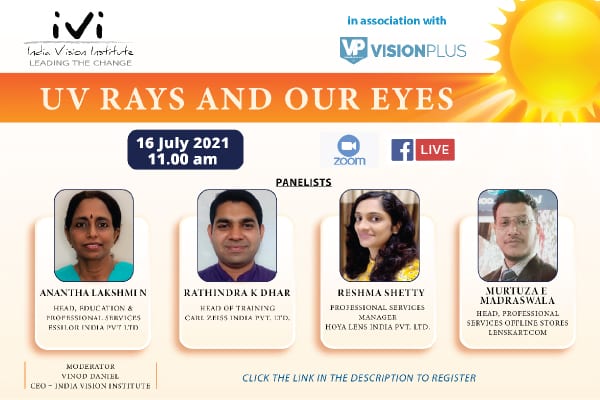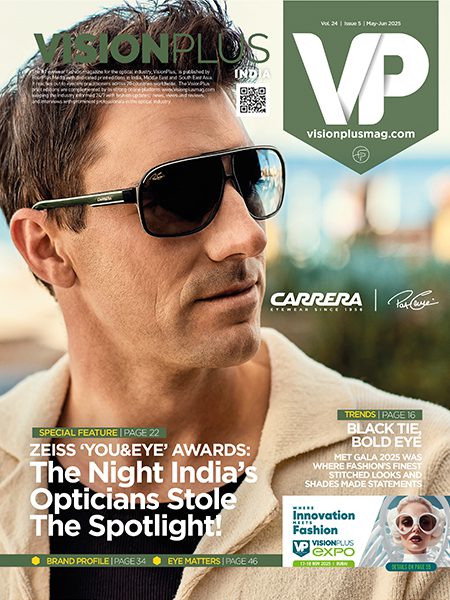In popular perception, eye health and safety are often associated with conditions such as refractive error and also the physical safety aspects of wearing spectacles, such as the risk of eye injuries caused by damaged spectacles. In reality, however, eye health and safety encompass a lot more and includes protection against harmful radiation. Ultraviolet (UV) radiation is extremely harmful for our eyes. Research shows a correlation between long-term exposure to UV rays and ocular pathologies such as Cataract, Pterygium, and Pinguecula.
An India Vision Institute (IVI)-VisionPlus Magazine-hosted panel discussion, ‘UV Rays and Our Eyes,’ July 16, saw experts in the field of eye care explaining the effects of UV radiation on our eyes and sharing ideas and mitigation strategies to best deal with the challenge.
Moderated by IVI’s CEO, Vinod Daniel, the panel comprised Ananthalakshmi N, Head, Education & Professional Services, Essilor India Pvt. Ltd., Rathindra K Dhar, Head of Training, Carl Zeiss India Pvt. Ltd., Reshma Shetty, Professional Services Manager, Hoya Lens India Pvt. Ltd., and Murtuza E Madraswala, Head, Professional Services Offline Stores, Lenskart.com.
Studies have shown that only about 7% of people are aware of the threat UV radiation poses to eye health and safety. Yet, it is estimated that as many as 850 million people worldwide will have eye conditions by 2050. Two of the types of UV rays that reach the earth’s surface are UVB and UVA. UVB rays are responsible for producing sunburn. UVB rays also play a major role in causing cataract formation and are primarily absorbed by the conjunctiva and cornea. Studies show a direct correlation between UV radiation and cataracts. An estimated 25% of people have cataracts because of UV exposure.
Outdoor workers are 10-20% more exposed to UV light compared to those who work indoors. Children are also more exposed because they tend to stay outdoors for long periods of time. Studies show that while many people apply sunscreen on their skin when they step outdoors, only a fraction of people are likely to wear sunglasses. Rathindra Dhar said, “We take care of our skin and other parts of the body, but when it comes to our eyes, we are not doing enough to protect them from UV rays. There is a need for all of us to wear eyewear that offers UV protection.”
Vinod Daniel observed that many tend to have the misconception that UV light is only a problem for the eyes outdoors and on sunny days. He asked if this myth could be dispelled. Ms Ananthalakshmi noted that while the major source of UV radiation that harms our eyes is the Sun, UV rays also affect our eyes indoors. ``As much as 50% UV rays are reflected off our surroundings. So it is not just direct UV rays that reach your eyes. UV radiation enters your eyes not only when you stand directly exposed to sunlight, they come from all directions, she added. Artificial sources of light found in homes and indoors can also emit UV rays. Halogen light bulbs, fluorescent lamps and other forms of artificial indoor lighting are also sources of UV rays.”
“It’s not necessary to wear sunglasses indoors in order to protect your eyes from UV rays,” said Murtuza Madraswala. “Clear lenses capable of offering UV protection are available.” A customer’s daily activities and needs determine the type of UV protection his or her eyes need. Eye care academia, practitioners and industry could consider developing a standardised questionnaire that enables opticians to understand the needs of individual customers. The questionnaire may, for example, have questions aimed at understanding the time a customer spends outdoors, the activities performed on a daily basis, type of indoor lighting at home or in the office, and other factors relevant to arriving at the optimum UV-protection solution.
“An average person looks at sunglasses as a style statement and not as a health statement,” Mr Daniel said, “how do we change the popular view of sunglasses, from a style accessory to something that is important for health?” The panel felt that public perception that sunglasses are only style accessories will not change in the immediate future. Ms Reshma Shetty said, “This perception will not change all of a sudden. It requires community messaging over a long period of time. Community messaging can gradually awaken society to the benefits of wearing sunglasses.”
Noting that rural areas pose a significant challenge because of a general lack of eye health awareness and the number of people who work outdoors in professions such as farming, Vinod Daniel asked the panelists to suggest ways of ensuring that even people in rural communities have access to eyewear that protects their eyes from the ill-effects of harmful UV radiation. According to Ms Ananthalakshmi, a lot boils down to awareness. In metro cities, awareness can be easily spread through electronic and digital media. That strategy may not be sufficient in rural areas, where there is a need to involve health workers who take these messages to people in remote villages. Rural health workers can raise awareness on eye health issues related to UV rays and educate them on the health benefits of wearing sunglasses and eyewear that protects the eyes from harmful UV rays.








